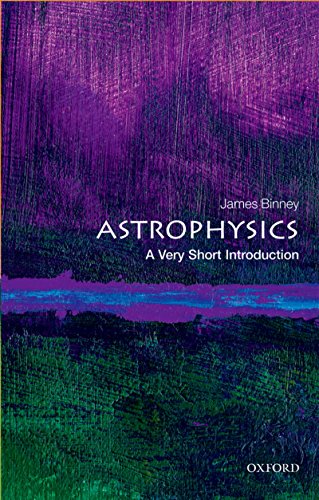
Ebook Info
- Published: 2016
- Number of pages: 176 pages
- Format: PDF
- File Size: 3.20 MB
- Authors: James Binney
Description
Astrophysics is the physics of the stars, and more widely the physics of the Universe. It enables us to understand the structure and evolution of planetary systems, stars, galaxies, interstellar gas, and the cosmos as a whole.In this Very Short Introduction, the leading astrophysicist James Binney shows how the field of astrophysics has expanded rapidly in the past century, with vast quantities of data gathered by telescopes exploiting all parts of the electromagnetic spectrum, combined with the rapid advance of computing power, which has allowed increasingly effective mathematical modelling. He illustrates how the application of fundamental principles of physics – the consideration of energy and mass, andmomentum – and the two pillars of relativity and quantum mechanics, has provided insights into phenomena ranging from rapidly spinning millisecond pulsars to the collision of giant spiral galaxies. This is a clear, rigorous introduction to astrophysics for those keen to cut their teeth on a conceptualtreatment involving some mathematics.ABOUT THE SERIES: The Very Short Introductions series from Oxford University Press contains hundreds of titles in almost every subject area. These pocket-sized books are the perfect way to get ahead in a new subject quickly. Our expert authors combine facts, analysis, perspective, new ideas, and enthusiasm to make interesting and challenging topics highly readable
User’s Reviews
Reviews from Amazon users which were colected at the time this book was published on the website:
⭐…of the night sky, just like those goat-herders of 5,000 years ago.My introduction to cosmology came at an early age, with George Gamow and Fred Hoyle, each postulating an entirely difference vision of the universe, the “Big Bang” vs “the Steady State.” In 1960, it was still an open question. In the subsequent half century plus, humankind has made stunning progress in understanding those many stars (and galaxies) over our heads. If we had only made as much progress on how to get along with one another…This is my fifth work that I have read in the “A Very Short Introduction” series. I have found each to be well written, dense, meaningful reviews of a given subject. The author, James Binney, has provided a wonderful summary of the exponential grow in our knowledge of the stars above, which has been greatly facilitated by a similar exponential growth in computing power.Binney commences with the “big ideas” that were determined by Newton and Maxwell, that is, formulating the mathematical equations that described the process of the physical world. Defining them in terms of their observations of these processes on earth, and then realizing that these same equations (sometimes subsequently adjusted for Einstein’s relativistic equations) applied to matter and energy on the far side of the universe, remains a remarkable achievement.The author covers stars and galaxies, and how they are formed from the gases between the stars. Fifty years ago giant red stars and white dwarfs were known, but not black holes… where the matter is so dense that no light can escape from them. So how do we know they exist? By carefully analyzing the motion of adjacent stars, particularly in binary pairs. So much information is gained by simply analyzing the spectrum of light emitted, and the red shift of these spectrum. How do we know there are other planetary systems? By the luminosity of the star as the planets pass in front of them…and realizing that this must be distinguished from other reasons for fluctuations in luminosity.Our own planetary system is somewhat of a “fluke” in that the orbits of the planets are largely circular, and have avoided the normal instability of extreme elliptical orbits, which would pull a planet into the sun, or throw it completely out of the system. The perturbations to a given orbit, due to the tug and pull of all the other bodies of mass, could only be accurately modeled with modern computing power. And our sun is also in an orbit within the galaxy, and somehow we (as in a very few people) have figured out that “…56 per cent of the gravitational force that holds the Sun in its orbit is generated by dark matter so only 44 per cent is generated by stars.” And 50 years ago, no one knew of “dark matter.” As Binney says: “At heart cosmology is about three fluids: dark energy which nobody understands; dark matter which nobody can see; and the cosmic microwave radiation.This work has more equations that some of the other scientific works in this series. I do not fault placing the equations in the work, but they should be more readable, even after they have been increased in size in full view mode, and thus in the Kindle edition, they should be increased by 2-3 font sizes. There are also some useful graphs and pictures that the goat herders of old could only dream of… though a few saw the explosions of supernova, to which religious significance was often attached. Overall, another 5-star… as it were… read.
⭐Because it was billed as “very short,” I expected this introduction to be rather cursory. Nothing could be farther from the truth. Virtually every page was filled with detailed information. Although this required somewhat slow and methodical reading, it was refreshingly free of superfluous rambling. An example of slow reading was the short final chapter, during which I felt the need to consult a redshift z calculator each time a new evolutionary epoch was addressed. In all, I found it a very informative, no-nonsense introduction to a fascinating field of study.
⭐There are so many good insights woven across each chapter. It’s like a feast of understanding of stars, interstellar medium, and galaxies. Just the right mixture of data and equations that someone looking for more than an introduction to Astronomy will love. Nothing but praise for the author, who clearly explains each topic and how they relate to our current understanding of stellar evolution, galaxies, and the universe.If you are interested in Astronomy, and want more than just introductions, buy this, and read it.The author does a great job of sharing his deep understandings of the topic, so that even a lay person can understand. Well worth the journey!
⭐Concise. Not simple nor too in-depth.
⭐Excellent short introduction. Assumes completion of high school physics classes to UK A level equivalent. The very short format is both a blessing for ensuring brevity, and a curse at times where more detail would have been welcome. The author has done a first class job given the limits of the series.
⭐I’d recommend this book for young people thinking about studying astronomy in college so they can get a feel for the topics and math and physics.
⭐This is the book to have for anyone interested in astrophysics. For the price and size of this book, you get a lot of information.
⭐A somewhat difficult read, the work does an excellent job in describing what is known and not known. Stick to it through the reading and you will learn the essentials.
⭐The concepts covered in this very short introduction are covered well, but I think someone without good mathematical competence would struggle to get some of the ideas. I felt that the text could be used differently to explain difficult concepts, rather than using at times relatively unfathomable graphs. In some cases formulae we’re used and all the terms in the formula were not explained well. Coming fresh to this someone wanting to get a very short introduction might just give up. This would be a shame, because the subject matter is hugely interesting, especially the material that relates to quasars.Definitely not a light read (no pun intended).
⭐It may be a very short introduction, but I’ve so far got only about 40% through it. Though I started from a 1950s engineering degree and a continued interest in astronomy, I’ve had to re-read several sections. But it does usefully go into much more detail than I had been aware of. I’ll continue working through it.
⭐Nice little book outlining principles of Astrophysics – I am studying a PT masters in Astrophysics, so a nice little crammer book. Fascinating field.
⭐Good quality into to this topic
⭐Great.
Keywords
Free Download Astrophysics: A Very Short Introduction (Very Short Introductions) in PDF format
Astrophysics: A Very Short Introduction (Very Short Introductions) PDF Free Download
Download Astrophysics: A Very Short Introduction (Very Short Introductions) 2016 PDF Free
Astrophysics: A Very Short Introduction (Very Short Introductions) 2016 PDF Free Download
Download Astrophysics: A Very Short Introduction (Very Short Introductions) PDF
Free Download Ebook Astrophysics: A Very Short Introduction (Very Short Introductions)

